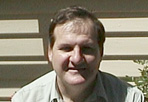System

27 September 1999
|
System |
 |
27 September 1999 |
|
Hugh R. Dean |
My 28W rms monoblock Glass Harmony amps were designed over a three year period. Voltage amplification is handled by an octal 6SL7 twin triode, while current amplification is by a single-ended mosfet output stage. Each channel dissipates 150W of heat continuously. No global feedback is used; frequency response is 3dB down at 25Hz and 75KHz. The interface between the tube and the output stage was a particularly difficult technical problem and easily consumed two years. The amp has vanishingly low output impedance, and sounds very powerful, but has stunning resolution and refinement. It is quite possible to distinguish different samples of the same tube from a short listen. I believe it is this detail which brings out the emotion in the music; this is an amp which makes you weep, particularly on female vocals. These amplifiers are now a commercial product, built to order. Recently I designed and built up a dual mono water cooled version of the Glass Harmony, dissipating a total of 600 watts of heat and producing 55W rms per channel. This amplifier is visible in the picture, and delivers an even more effortless performance with no loss of detail or refinement. However, the cooling system is more akin to a hospital than a home, and while this is my "benchmark" amp, it is not practical. The speakers were developed by a friend in the Melbourne Audio Club; they are three way with a passive radiator, a second order crossover. They use a Scan tweeter, a B&W midrange with Al 160 micron spun aluminium cone, and a Scanspeak 170mm woofer with excursion modified to +/- 7mm. They are 3dB down at 32Hz and 22KHz, of 90dB/watt/metre. Their bass is astonishing. The unmodified Denon CD Player is now the weak link in the chain. I do have a Lux glass platter turntable with a Stax arm and a Grace cartridge but am not using it at present. I recently designed a transformer coupled, differential analogue output stage for a recently acquired Crystal CS4390 evaluation board, and hope to complete it by year’s end. I enjoy a wide variety of music, ranging from classical through modern jazz to popular. I particularly enjoy orchestral music, Northern European jazz and acoustic rock. I believe that a hifi system is approaching nirvana when it makes you weep. System's
Components
Hugh's comments about his System: AA: "Hugh, how would
you describe your system's sound?"
ASPEN AMPLIFIERS web site |
Home